Afrikakorps Heer Pith Helmet (1st version)
CATEGORY: Version
SKU: 23.GOR.01.02.02.001.000
Estimated market value:
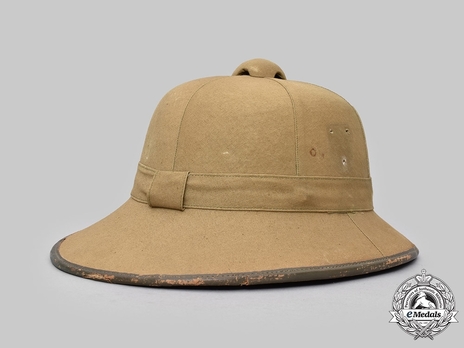
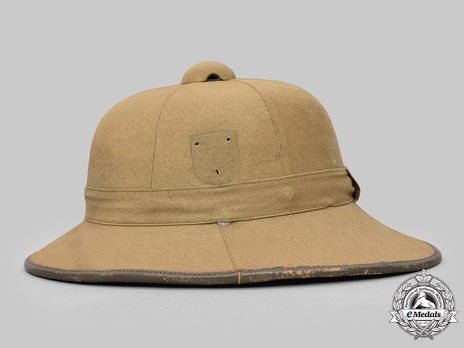
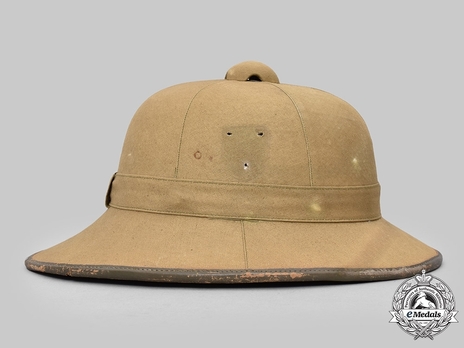
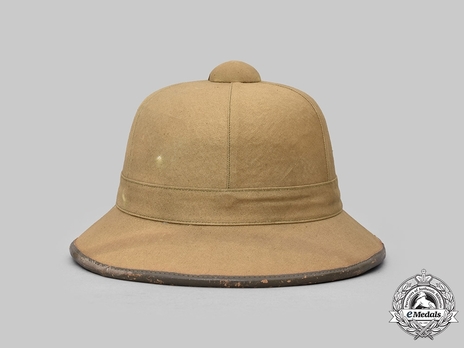
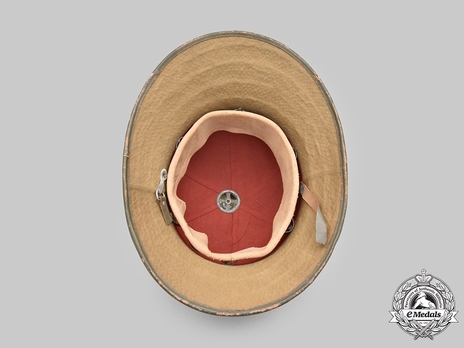
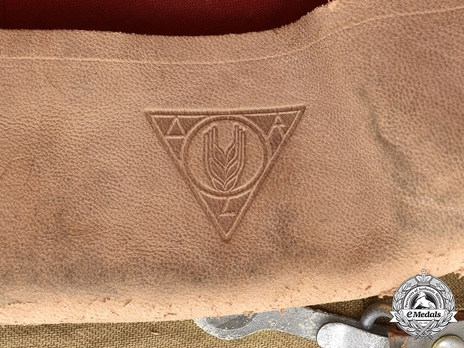
Estimated market value:
A well-preserved, first-pattern Heer tropical helmet, constructed of a woven wicker shell consisting of a central canister with an outward-flaring brim. The exterior is fully lined in a khaki-coloured canvas twill liner. Topping the crown is a zink-reinforced ventilation shaft opening into the interior, with a canvas-lined rounded swivel guard set at the exterior. A band of khaki-coloured cotton twill lines the exterior at the seam of the brim. The canister is flanked on each side with three holes for the accommodation of insignia, which have since been lost. Completing the exterior features is a grey leather liner reinforcing the rim, secured in place with machine stitching. Riveted to the circumference of the interior is a grey bakelite composite band which secures in place a light brown leather sweatband, reinforced with a grey wool liner, while two short lengths of brown leather emanate from the sides of the shell. The latter are the remnants of a chinstrap which has since been lost. A red cotton twill liner fully encompasses the interior of the cylinder. Double maker’s mark are set into the sweatband, with an embossed logo of “ORL” on the exterior, and a stamped “ORL” mark on the interior with a manufacture date of “1942”. An additional illegible size stamp is set onto the reverse of the sweatband. The helmet measures 280 mm (w) x 360 mm (l) x 180 mm (h). In addition to the missing insignia and chinstrap, some issues consistent with age and use are evident, and include material fatigue of the leather elements, some oxidation of the zink reinforcements, and minor soiling of the canvas. This field-used example is in an overall very fine condition.
During the Second World War, German troops stationed in northern Africa are generally referred to as the Afrikakorps. Technically, this is not entirely correct, since some German units operating in Africa were not actually part of the DAK (Deutsches Afrikakorps), and some units of it were, in fact, Italian ones. However, for the purpose of collecting so-called “tropical” uniforms and insignia, collectors have simplified the meaning of the term.
The first German troops were sent to northern Africa in February of 1941, to support their Italian allies against the British. The climate of the African continent made it necessary to wear specialised uniforms and gear that not only supported the soldiers in serving in a hot and arid environment, but also helped them in blending in with the landscape, which, in general, presented itself as brown, olive, khaki, or sand/tan in colour. Worn over long periods of time under the blistering desert sun, some uniforms were eventually bleached to white or off-white. Uniforms and insignia in these colours are often referred to as “tropical”, and it is worth noting that they weren’t just worn by members of units stationed in Africa, but in the entire Mediterranean theatre of war, including southern France, Italy, the Balkans, and Greece, as well as in southern Russia during the summer months. Tropical uniforms were worn by members of all three branches of the Wehrmacht: the Heer (army), the Kriegsmarine (navy), and the Luftwaffe (air force). Members of the Waffen-SS stationed in southerly regions also wore tropical-style uniforms, and even though they technically have no connection to the DAK, all tropical uniforms and insignia of all branches of the German military are listed here.
The helmet of the Army became one of the most recognisable items of the German soldier in the Second World War, just like the “Pickelhaube”, the spiked helmet, had come to be a symbol associated with the German Imperial Army. However, where the spiked helmet fulfilled more of a ceremonial function, the steel helmet was intended as a practical item for the battlefield, designed to protect and shield its wearer from grenade splinters and other forms of shrapnel.
Helmets will vary in appearance due to production by different factories and subcontractors, and changes in specifications.
The Pith Helmet had been developed for tropical regions and was in use since the days of colonialism. Its main feature was that it was significantly more light in weight than a regular helmet. During the Second World War it was worn by enlisted men and officers of all ranks.
It has a pressed cork body. There are also rarer versions made of wicker or straw. It usually has a leather sweatband and a leather chinstrap. On this helmet the tricoloured and eagle shield decals weren’t painted versions, like on the steel helmets, but badges pinned to the helmet.
There are two versions of the pith helmet. The first version is covered with a lightweight canvas which is either green or tan in colour. The dome is covered by six pieces of cloth sewn together, with a cloth band at the base to cover the sewn junction.
The second version instead has a one-piece seamless cover made of felt.

Comments
Sign in to comment and reply.


Scroll Top